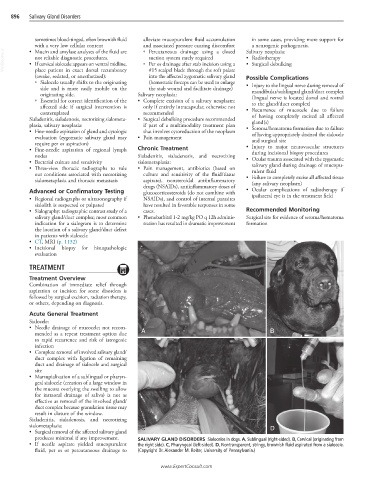Page 1789 - Cote clinical veterinary advisor dogs and cats 4th
P. 1789
896 Salivary Gland Disorders
sometimes blood-tinged, often brownish fluid alleviate mucopurulent fluid accumulation in some cases, providing more support for
with a very low cellular content and associated pressure causing discomfort Salivary neoplasia:
a neurogenic pathogenesis.
VetBooks.ir • If cervical sialocele appears on ventral midline, ○ Per os drainage after stab incision using a • Radiotherapy
○ Percutaneous drainage using a closed
• Mucin and amylase analyses of the fluid are
suction system rarely required
not reliable diagnostic procedures.
• Surgical debulking
place patient in exact dorsal recumbency
into the affected zygomatic salivary gland
(awake, sedated, or anesthetized): #15 scalpel blade through the soft palate Possible Complications
○ Sialocele usually shifts to the originating (hemostatic forceps can be used to enlarge
side and is more easily mobile on the the stab wound and facilitate drainage) • Injury to the lingual nerve during removal of
mandibular/sublingual gland/duct complex
originating side. Salivary neoplasia:
○ Essential for correct identification of the • Complete excision of a salivary neoplasm: (lingual nerve is located dorsal and rostral
to the gland/duct complex)
affected side if surgical intervention is only if entirely intracapsular, otherwise not • Recurrence of mucocele due to failure
contemplated recommended
Sialadenitis, sialadenosis, necrotizing sialometa- • Surgical debulking procedure recommended of having completely excised all affected
gland(s)
plasia, salivary neoplasia: if part of a multimodality treatment plan • Seroma/hematoma formation due to failure
• Fine-needle aspiration of gland and cytologic that involves cytoreduction of the neoplasm of having appropriately drained the sialocele
evaluation (zygomatic salivary gland may • Pain management and surgical site
require per os aspiration)
• Fine-needle aspiration of regional lymph Chronic Treatment • Injury to major neurovascular structures
during incisional biopsy procedures
nodes Sialadenitis, sialadenosis, and necrotizing
• Bacterial culture and sensitivity sialometaplasia: • Ocular trauma associated with the zygomatic
salivary gland during drainage of mucopu-
• Three-view thoracic radiographs to rule • Pain management, antibiotics (based on rulent fluid
out conditions associated with necrotizing culture and sensitivity of the fluid/tissue • Failure to completely excise all affected tissue
sialometaplasia and thoracic metastasis aspirate), nonsteroidal antiinflammatory (any salivary neoplasm)
drugs (NSAIDs), antiinflammatory doses of
Advanced or Confirmatory Testing glucocorticosteroids (do not combine with • Ocular complications of radiotherapy if
• Regional radiographs or ultrasonography if NSAIDs), and control of internal parasites ipsilateral eye is in the treatment field
sialolith is suspected or palpated have resulted in favorable responses in some
• Sialography: radiographic contrast study of a cases. Recommended Monitoring
salivary gland/duct complex; most common • Phenobarbital 1-2 mg/kg PO q 12h adminis- Surgical site for evidence of seroma/hematoma
indication for a sialogram is to determine tration has resulted in dramatic improvement formation
the location of a salivary gland/duct defect
in patients with sialocele
• CT, MRI (p. 1132)
• Incisional biopsy for histopathologic
evaluation
TREATMENT
Treatment Overview
Combination of immediate relief through
aspiration or incision for some disorders is
followed by surgical excision, radiation therapy,
or others, depending on diagnosis.
Acute General Treatment
Sialocele:
• Needle drainage of mucocele; not recom- A B
mended as a repeat treatment option due
to rapid recurrence and risk of iatrogenic
infection
• Complete removal of involved salivary gland/
duct complex with ligation of remaining
duct and drainage of sialocele and surgical
site
• Marsupialization of a sublingual or pharyn-
geal sialocele (creation of a large window in
the mucosa overlying the swelling to allow
for intraoral drainage of saliva) is not as
effective as removal of the involved gland/
duct complex because granulation tissue may
result in closure of the window.
Sialadenitis, sialadenosis, and necrotizing
sialometaplasia: C C D
• Surgical removal of the affected salivary gland
produces minimal if any improvement. SALIVARY GLAND DISORDERS Sialoceles in dogs. A, Sublingual (right-sided). B, Cervical (originating from
• If needle aspirate yielded mucopurulent the right side). C, Pharyngeal (left-sided). D, Nontransparent, stringy, brownish fluid aspirated from a sialocele.
fluid, per os or percutaneous drainage to (Copyright Dr. Alexander M. Reiter, University of Pennsylvania.)
www.ExpertConsult.com

